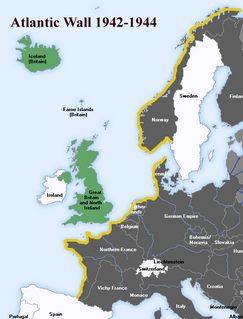 W
WThe Atlantic Wall was an extensive system of coastal defences and fortifications built by Nazi Germany between 1942 and 1944, along the coast of continental Europe and Scandinavia as a defence against an anticipated Allied invasion of Nazi-occupied Europe from the United Kingdom, during World War II. The manning and operation of the Atlantic Wall was administratively overseen by the German Army, with some support from Luftwaffe ground forces. The Kriegsmarine maintained a separate coastal defence network, organised into a number of sea defence zones.
 W
WBattery Oldenburg is a German artillery battery, built during World War II as part of the Atlantic Wall, and situated east of Calais. The battery began in 1940 with artillery guns in an open emplacement. The Organisation Todt built casemates around two 240mm guns during the war.
 W
WThe Blockhaus d'Éperlecques is a Second World War bunker, now part of a museum, near Saint-Omer in the northern Pas-de-Calais département of France, and only some 14.4 kilometers north-northwest from the more developed La Coupole V-2 launch facility, in the same general area.
 W
WBrécourt was a Nazi Germany bunker in Équeurdreville-Hainneville near Cherbourg, in Manche of Normandy, northern France.
 W
WThe Café Gondrée is a small coffeehouse in the French community of Bénouville. The cafe is located on the west bank of the Caen Canal, at the northwest end of the Bénouville Bridge, now commonly referred to as the Pegasus Bridge. The building was the site of first combat during the D-Day invasion, and is best known for its role commemorating those events.
 W
WCarentan is a small rural town near the north-eastern base of the French Cotentin Peninsula in Normandy in north-western France near the port city of Cherbourg, with a population somewhat over 6,000. It is a former commune in the Manche department. On 1 January 2016, it was merged into the new commune of Carentan-les-Marais. The town was a strategic early goal of the World War II landings as capturing the town was necessary to link the lodgements at Utah and Omaha beaches which were divided by the Douve River estuary. The town was also needed as an intermediate staging position for the capture of the cities of Cherbourg and Octeville, with the critically important port facilities in Cherbourg.
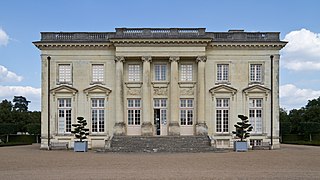 W
WThe Chateau de Pignerolle is located to the east of Angers in the commune of Saint-Barthélemy-d'Anjou in the department of Maine-et-Loire in France.
 W
WOperation Jubilee or the Dieppe Raid was an Allied amphibious attack on the German-occupied port of Dieppe, northern France in the Second World War. Over 6,050 infantry, predominantly Canadian, supported by a regiment of tanks, were put ashore from a naval force operating under protection of Royal Air Force (RAF) fighters.
 W
WThe Dover Strait coastal guns were British and German long-range coastal artillery pieces, on the English Channel coasts of Kent, England and the Pas-de-Calais, occupied France. The Strait of Dover is the narrowest channel between England and continental Europe. During the Second World War, both sides used their guns to bombard shipping in the Channel as well as coastal towns and military installations.
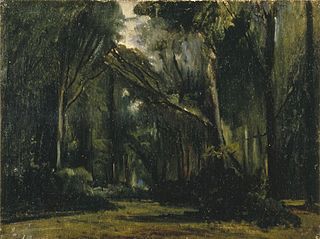 W
WThe Forest of Compiègne is a large forest in the region of Picardy, France, near the city of Compiègne and approximately 60 kilometres (37 mi) north of Paris.
 W
WThe Hillman Fortress was a German bunker complex and command post built during the Second World War and located near Colleville-Montgomery in Normandy, France. The bunker complex, designated as Hill 61 and codenamed Hillman by the British, was attacked on 6 June 1944 by the Suffolk Regiment and the fortress finally surrendered the following morning. The delay in taking the bunker complex has been cited as a reason for the Allies not completing their major D-Day objective of taking Caen.
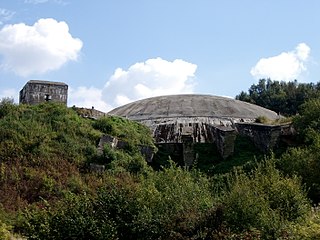 W
WLa Coupole, also known as the Coupole d'Helfaut-Wizernes and originally codenamed Bauvorhaben 21 or Schotterwerk Nordwest, is a Second World War bunker complex in the Pas-de-Calais department of northern France, about 5 kilometres (3.1 mi) from Saint-Omer, and some 14.4 kilometers south-southeast from the less developed Blockhaus d'Eperlecques V-2 launch installation in the same area. It was built by the forces of Nazi Germany between 1943 and 1944 to serve as a launch base for V-2 rockets directed against London and southern England, and is the earliest known precursor to modern underground missile silos still in existence.
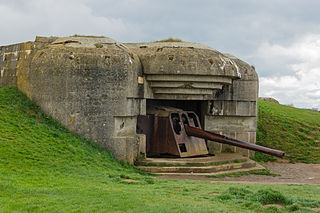 W
WThe Longues-sur-Mer battery was a World War II German artillery battery constructed near the French village of Longues-sur-Mer in Normandy. The battery was sited on a 60 m (200 ft) cliff overlooking the sea and formed a part of Germany's Atlantic Wall coastal fortifications. It was located between the Allied landing beaches of Gold and Omaha and shelled both beaches on D-Day. The battery was captured on June 7 and played no further part in the Normandy campaign.
 W
WThe Maisy Battery is a group of World War II artillery batteries constructed by the German Wehrmacht near the French village of Grandcamp-Maisy in Normandy. It formed a part of Germany's Atlantic Wall coastal fortifications and was the principal position of defence for that area. It was responsible for the defense of the sector between the Longues-sur-Mer and the St Marcouf (Crisbecq) batteries. It could target the sectors around both Omaha Beach and Utah Beach, two of the five landing sites for the Allied invasion of Normandy in June 1944.
 W
WThe Merville Gun Battery is a decommissioned coastal fortification in Normandy, France, which was built as part of the Germans' Atlantic Wall to defend continental Europe from Allied invasion. It was a particularly heavily fortified position and one of the first places to be attacked by Allied forces during the Normandy Landings commonly known as D-Day. A British force under the command of Terence Otway succeeded in capturing this position, suffering heavy casualties.
 W
WThe Fortress of Mimoyecques is the modern name for a Second World War underground military complex built by the forces of Nazi Germany between 1943 and 1944. It was intended to house a battery of V-3 cannons aimed at London, 165 kilometres (103 mi) away. Originally codenamed Wiese ("Meadow") or Bauvorhaben 711, it is located in the commune of Landrethun-le-Nord in the Pas-de-Calais region of northern France, near the hamlet of Mimoyecques about 20 kilometres (12 mi) from Boulogne-sur-Mer. It was constructed by a mostly German workforce recruited from major engineering and mining concerns, augmented by prisoner-of-war slave labour.
 W
WPegasus Bridge, originally called the Bénouville Bridge after the neighbouring village, is a road crossing over the Caen Canal, between Caen and Ouistreham in Normandy. The original bridge, built in 1934, is now a war memorial and is the centrepiece of the Memorial Pegasus museum at nearby Ranville. It was replaced in 1994 by a modern design which, like the old one, is a bascule bridge.
 W
WLa Pointe du Hoc is a promontory with a 100-foot (30 m) cliff overlooking the English Channel on the northwestern coast of Normandy in the Calvados department, France.
 W
WPoix-de-Picardie is a commune in the Somme department in Hauts-de-France in northern France.
 W
WSaint-Inglevert Airfield is a general aviation airfield at Saint-Inglevert, Pas-de-Calais, France. In the First World War an airfield was established near Saint-Inglevert by the Royal Flying Corps, later passing to the Royal Air Force on formation and thus becoming RAF Saint Inglevert.
 W
WSaint-Leu-d'Esserent is a commune in the Oise department in northern France.
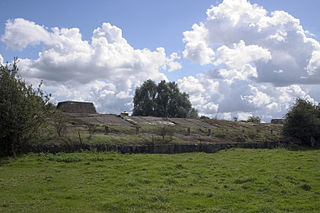 W
WThe Siracourt V-1 bunker is a Second World War bunker built in 1943–44 by the forces of Nazi Germany at Siracourt, a commune in the Pas-de-Calais department in the Nord-Pas-de-Calais region of France. Codenamed Wasserwerk St. Pol, it was intended for use as a bomb-proof storage facility and launch site for V-1 flying bombs. However it never went into operation due to intensive Allied bombing that made it the most heavily attacked of all the German V-weapon sites, and also of all military targets in Europe during World War II.
 W
WSottevast was a Second World War bunker complex for launching V2-weapons in Sottevast near Cherbourg, in Normandy, France. It was built, under the codename Reservelager West, by the forces of Nazi Germany between 1943 and 1944 to serve as a launch base for V-2 rockets directed against southern England.
 W
WThe Todt Battery, also known as Batterie Todt, was a battery of coastal artillery built by the Nazi Germany in World War II, located in the hamlet of Haringzelles, Audinghen, near Cape Gris-Nez, Pas de Calais, France.
 W
WIn order to carry out the planned V-1 "flying bomb" attacks on the United Kingdom, Germany built a number of military installations including launching sites and depots. Some of the installations were huge concrete fortifications.
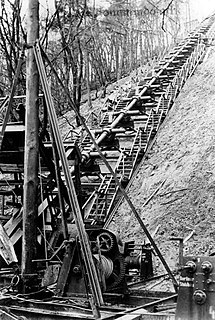 W
WThe V-3 was a German World War II large-caliber gun working on the multi-charge principle whereby secondary propellant charges are fired to add velocity to a projectile.
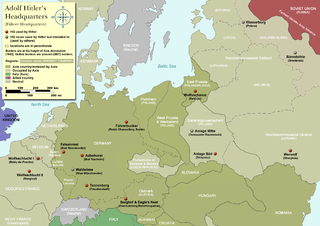 W
WFührerhauptquartier Wolfsschlucht II or W2 was the codename used for one of Adolf Hitler's World War II Western Front military headquarters located in Margival, 10 km northeast of Soissons in the department of Aisne in France. It was one of many Führer Headquarters throughout Europe but was used only once by Adolf Hitler, June 16 and 17, 1944 for a meeting with Field Marshals Erwin Rommel and Gerd von Rundstedt about the Normandy Front.